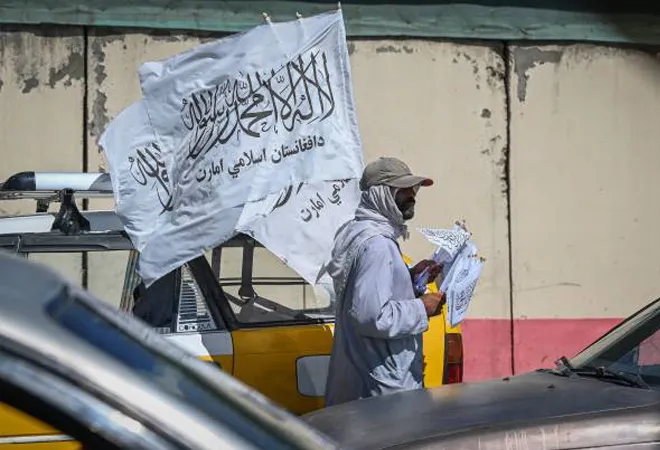
In the politics of war, both sides of the conflict use different propaganda methods to shape domestic and international opinion in their favour. In the case of Afghanistan, only one side of the conflict seems to be, both intentionally and unintentionally, winning the propaganda war, weaving a narrative of victory that is quickly becoming the reality on the ground. Unfortunately for us, that narrative is the Taliban’s.
While violence and fighting between the Taliban and the Afghan National Defence and Security Forces (ANDSF) has been ongoing, the White House announcement that the United States would withdraw all its forces from the country by September 2021, has led to a drastic uptick in Taliban violence. The Long War Journal, which has been tracking the battle, assesses that the number of districts under Taliban control rose from 73 to 157, between 1 May and 29 June 2021. Given the speed with which the Taliban is apparently seizing control over districts, the numbers and data of districts under their authority are rapidly changing by the day. As of 8 July, according to the Long War Journal, 50 percent of all the districts in Afghanistan are controlled by the Taliban.
The group has repeatedly shown that it has not changed and remains the depraved, radical, terrorist group it has always been.
This is a terrifying assessment, if accurate. The Taliban’s expanding footprint across the country conjures up a horrific image of what would happen should the Taliban continue to control and rule the population that is under their control. The group has repeatedly shown that it has not changed and remains the depraved, radical, terrorist group it has always been.
While the Taliban being on a rampage across Afghanistan is a fact, the continuous media coverage of the said rampage and the fall of districts to Taliban control in all parts of the country has helped the terrorist group tremendously. News media around the world have focused on how the Taliban has won over many districts, and on how the ANDSF was cornered by militants, fled into Tajikistan — without further substantiating on the gains made by the latter on the battle field. By ignoring or giving little coverage to the actions of the Afghan army and the number of districts that they have been able to win back from the Taliban, the media has given the Taliban the coverage they seek, which will make them seem powerful and invincible, and has also provided free publicity, allowing the Taliban to boast of their ‘conquests’ and ‘victories.’
By ignoring or giving little coverage to the actions of the Afghan army and the number of districts that they have been able to win back from the Taliban, the media has given the Taliban the coverage they seek.
Although the situation remains grim, the ANDSF have also had some small incidents of success in being able to retake certain districts that fell to the Taliban. However, there remain very few news reports that cover the gains made by them. While the Afghan Ministry of Defence website has been posting daily updates about the number of Taliban fighters killed every day, these numbers and information do not make it to newspaper headlines. The Taliban retain their monopoly over the news coming out of the country and, thereby, ensure that the steady flow of incidents that demonstrate their military strength further boost the morale of their cadre.
By focusing solely on the Taliban’s actions and how they have been “successful” at gaining more territory, and ignoring any, however small, positive actions or gains of the Afghan government and the Afghan army, news organisations around the world are guilty of contributing to the Taliban’s propaganda of their supposed invincibility. In some cases, their ability to capture a certain district has caused a domino effect, whereby the nearby districts have succumbed to the Taliban, putting up little resistance. Clickbait headlines and news articles dictating the conquests of the enemy has not only helped their agenda, but has also, in certain cases, reduced the will of people to resist them.
While everyone might not believe in the Taliban’s vision for the country, everyone agrees that the US needs to head home, something the Taliban have been advocating for.
The Taliban’s propaganda has also focused on delivering messages to its soldiers and attempting to maintain unity amongst them. In Sirajuddin Haqqani’s — who serves as the deputy leader for the group — latest message on 24 June, he addresses the group’s fighters over their “continuous series of conquests,” reminding them that the Taliban campaign is evolving from a “military and jihadi” campaign into a “civilian situation.” In other words, he believes that the Taliban will soon be in a position of governing authority and that the Taliban fighters must “behave well with the general public.” Such statements, of supposed impending victory, are sure to reinvigorate the fighters, strengthening their resolve to continue their actions, as well as lure more fighters into their movement.
Analysts have argued that the United States has, over the course of its two-decade-long stay in Afghanistan, lost the battle of the narrative. While everyone might not believe in the Taliban’s vision for the country, everyone agrees that the US needs to head home, something the Taliban have been advocating for. Now, with Washington in the process of withdrawing all its forces from the country, the argument that the US’s supposed goal of establishing a safe, democratic, and pluralistic Afghanistan is contradictory to its actions, has never been stronger. From giving Haqqani a platform in The New York Times to the Chairman of the Joint Chiefs of Staff, General Mark Milley, downplaying the Taliban’s battlefield success and particularly by the exiting of a US base without informing the Afghan forces, the US’s actions have played right into the Taliban’s agenda of demonstrating their own international legitimacy and their victory over a superpower.
If the Doha negotiations of 2020 provided a ray of optimism for the future, this year has brought on dark, foreboding clouds.
If the Doha negotiations of 2020 provided a ray of optimism for the future, this year has brought on dark, foreboding clouds. Any sort of vague resemblance to a peace process has quickly vanished and with it, the hope that last year’s agreement between the US and the Taliban, was the ‘best possible option’ for all sides. The Taliban have retreated or rather, not followed through at all, on any promise it had made under the agreement, continuing to make zero concessions as its fighters steadily close in on provincial capitals across the country. Out of the numerous scenarios imagined over the years on what would happen when the US leave, none of them were ever ideal. However, the current situation, where the Taliban continue to make military, political, and diplomatic gains on a daily basis, is probably the worst scenario of them all.
The views expressed above belong to the author(s). ORF research and analyses now available on Telegram! Click here to access our curated content — blogs, longforms and interviews.




 PREV
PREV


